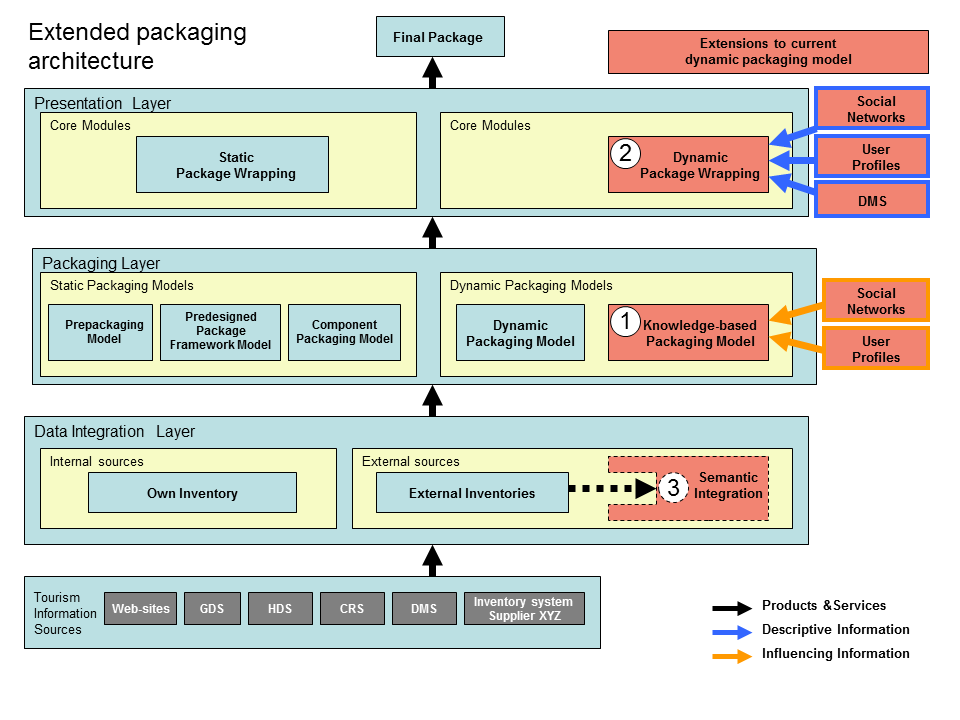Knowledge-based Dynamic Packaging Model

The following information is extracted from a paper published in the 2006 IEEE International Conference on Management of Innovation and Technology, as a result from the SEED Project developed by Expedita and Universidade da Madeira with financial support from Fundação para a Ciência e Tecnologia (Portuguese Government). For a complete reading or external references identification, please access the full paper in the conference proceedings.
Abstract
The rapid growth of the Internet and the continual adoption of innovative technology have led to serious changes in the travel industry during the last decade. Due to the constantly changing business environment, one of the latest concepts of the tourist industry is “Dynamic Packaging”.
While Dynamic Packaging has been widely accepted by customers, the strategic impacts enabled by Dynamic Packaging technologies are still uncertain. This paper provides a study of an extension of the traditional packaging architecture and aims to present a new and extended model, called the Knowledge-based Dynamic Packaging Model.
Content
DEFINING DYNAMIC PACKAGING
Dynamic Packaging is a term that is used in various contexts. “For some it’s just a technology for others it is an overall merchandising solution” [Chicke Fitzgerald, 2005]. Several definitions can be found in the literature. Some are partly contradictorily or complementary.
According to Stephanie Lofgren, Dynamic Packaging is “an industry buzzword for enabling the consumer (or booking agent) to build a customized itinerary by assembling multiple components of their choices and complete the transaction in real time”. Trisept Solutions adds that Dynamic Packaging should provide a single, fully priced package (hiding the price of individual components) within 5-15 seconds. Fitzgerald identifies that one important requirement for Dynamic Packaging solution is the existence of an infrastructure to integrate data in an automated way, allowing querying in a uniform way across multiple heterogeneous systems containing tourism related information”. Trisept Solutions point out that it is not because there is only one payment transaction for all vacation components that it is a dynamically packaged reservation.
The key point of differentiation between dynamic and traditional vacation packages is the ability for the travel consumer to dynamically access data stored into several, separate inventory management systems. Meyer reiterates that a key characteristic of Dynamic Packaging is to be able to combine services which are described in local inventories or in external sources.
For us, Dynamic Packaging is based on an individual consumer request, including the ability to combine, multiple travel components like flights, hotels, car rentals, and any other tourism related component in real time and provides a single, fully priced package, requiring only one payment from the consumer and hiding the pricing of individual components. The products available to customer can be stored in local inventories or external sources.
EXTENDED PACKAGING ARCHITECTURE
The main components of the Extended Packaging Architecture are the knowledge-based packaging process influenced by the social network and the user profile component, the Dynamic Package Wrapping process including descriptive information from social networks, public websites and Destination Management Systems and as a desirable optional functionality semantic integration.
We will discuss each of those components individually in the next sections after presenting the different layers first.
A. Data Integration Layer
A modern Dynamic Packaging solution should be able to access product information stored in local database with own inventory and in external inventories with real time access or supported by cache mechanism.
Cooperating with a critical mass of suppliers from various travel industries is an essential prerequisite for providing customized travel products. In order to have access to up-todate information in real-time within tolerable response times it is crucial to establish linkages to diverse numbers of suppliers including the management of these business-to-business (B2B) links. Constrained by the own business it is of utmost importance to integrate Computerized Reservation Systems (CRS), Global distribution systems (GDS), Hotel distribution Systems (HDS) and Destination Management systems (DMS).
Furthermore it is necessary to integrate those systems that are not managed by the above mentioned systems, like for example airline’s, hotel’s or car rentals inventory systems or blocks of inventory managed by tour operators or vacation packager.
B. Packaging Layer
The packaging layer, the second layer of our extended
architecture, is composed of four packaging models, namely the prepackaging, predesigned package, component packaging, and dynamic packaging models.
C. Presentation Layer
The presentation layer is in our opinion deciding if the package solution will be successful or not. Similar to any other business it is of utmost importance to present the product in a convenient way. The question of how to wrap the package in order to attract the traveller is essential for turning lookers into bookers. What destination brochures have been for traditional offline travel agencies, is replaced nowadays by on-line multi-media enriched content supported by several sources. Without proper presentation the package is worthless and having a look on actual on-line offers it is to say that lately the major companies are taking enormous efforts to enhance their presentation layer, but that the offers of most small and medium-sized companies still
lack of proper shape of presentation. Instead of providing additional information only the pure facts like product name, price and time are given. Only customers whose only preference is to achieve the lowest price can be attracted in this way but even those may be disappointed afterwards.
IV. KNOWLEDGE-BASED DYNAMIC PACKAGING MODEL
The recent developments in Dynamic Packaging technology will enable to build a new breed of Dynamic Packaging solutions. In the following we present a new packaging model (Fig.3), which is based on an input of information concerning consumer experiences/reviews and individual user profiles gathered through social networks and personalized user accounts in order to create tailor-made packages with a maximum of customization. The model aims at pro-actively offerings wrapped in packages including destination information, information from social networks and public websites.

CONCLUSION
In our eyes the future of packaged travel is dynamic and knowledge-based. Implementing knowledge-based Dynamic Packaging suppliers will be enabled to meet the needs of their customer in a way that there will be a Win-Win- Situation for the travel industry and the traveller. However Knowledge-based Packaging solutions/systems cannot be successfully implemented without taking into account the importance of data and information integration. One effective way to achieve this integration is to use semantics. Without a doubt, the successful implementation of semantics will facilitate the organization and sharing of tourism information and will therefore allow better interoperability and integration of inter- and intra-company information systems.
Authors
Tobias Schmeing
University of Essen
Essen, Germany
Jorge Cardoso
Department of Mathematics and Engineering
University of Madeira
Funchal, Portugal
Jorge D. Fernandes
Expedita -Arquitectura e Gestão de Sistemas de Informação
Funchal, Portugal








